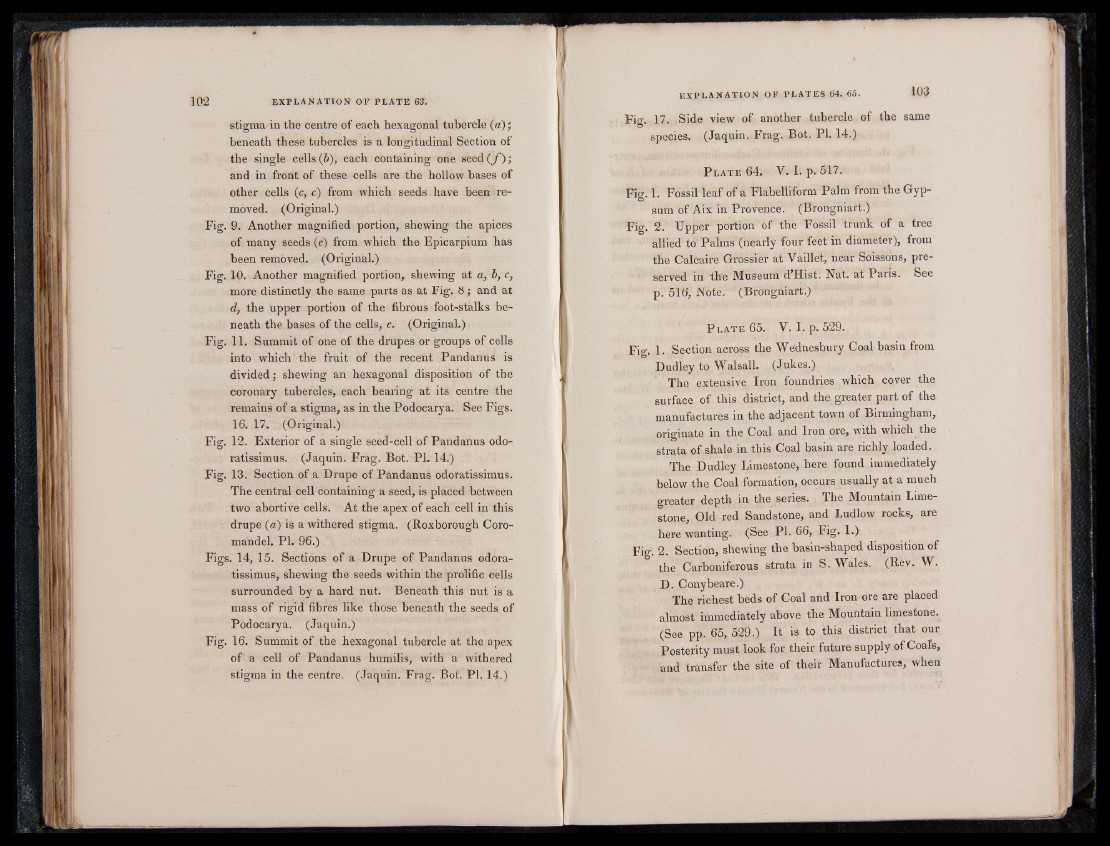
stigma in the centre of each hexagonal tubercle (a);
beneath these tubercles is a longitudinal Section of
the single cells (b), each containing one seed (f );
and in front of these cells are the hollow bases of
other cells (c, c) from which seeds have been removed.
. (Original.)
Fig. 9. Another magnified portion, shewing the apices
of many seeds (e) from which the Epicarpium has
been removed. (Original.)
Fig. 10. Another magnified portion, shewing at a, i, c,
more distinctly the same parts as at Fig. 8 ; and at
d, the upper portion of the fibrous foot-stalks beneath
the bases of the cells, c. (Original.)
Fig. 11. Summit of one of the drupes or groups of cells
into which the fruit of the recent Pandanus is
divided; shewing an hexagonal disposition of the
coronary tubercles, each bearing at its centre the
remains of a stigma, as in the Podocarya. See Figs.
16. 17. (Original.)
Fig. 12. Exterior of a single seed-cell of Pandanus odo-
ratissimus. (Jaquin. Frag. Bot. PI. 14.)
Fig. 13. Section of a Drupe of Pandanus odoratissimus.
The central cell containing a seed, is placed between
two abortive cells. At the apex of each cell in this
drupe (a) is a withered stigma. (Roxborough Coromandel.
PI. 96.)
Figs. 14, 15. Sections of a Drupe of Pandanus odoratissimus,
shewing the seeds within the prolific cells
surrounded by a hard nut. Beneath this nut is a
mass of rigid fibres like those beneath the seeds of
Podocarya. (Jaquin.)
Fig. 16. Summit of the hexagonal tubercle at the apex
of a cell of Pandanus humilis, with a withered
stigma in the centre. (Jaquin. Frag. Bot. PI. 14.)
Fig. 17. Side view of another tubercle of the same
species. (Jaquin. Frag. Bot. PI. 14.)
P l a t e 64. V. I. p. 517.
Fig. 1. Fossil leaf of a Flabelliform Palm from the Gypsum
of Aix in Provence. (Brongniart.)
Fig. 2. Upper portion of the Fossil trunk of a tree
allied to Palms (nearly four feet in diameter), from
the Calcaire Grossier at Vaillet, near Soissons, preserved
in the Museum d’Hist. Nat. at Paris. See
p. 516, Note. (Brongniart.)
P l a t e 65. V. I . p. 529.
Fig. 1. Section across the We'dnesbury Coal basin from
Dudley to Walsall. (Jukes.)
The extensive Iron foundries which cover the
surface of this district, and the greater part of the
manufactures in the adjacent town of Birmingham,
originate in the Coal and Iron ore, with which the
strata of shale in this Coal basin are richly loaded.
The Dudley Limestone, here found immediately
below the Coal formation, occurs usually at a much
greater depth in the series. The Mountain Limestone,
Old red Sandstone, and Ludlow rocks, are
here wanting. (See PL 66, Fig. 1.)
Fig. 2. Section, shewing the basin-shaped disposition of
the Carboniferous strata in S. Wales. (Rev. W.
D. Conybeare.)
The richest beds of Coal and Iron ore are placed
almost immediately above the Mountain limestone.
(See pp. 65, 529.) It is to this district that our
Posterity must look for their future supply of Coals,
and transfer the site of their Manufactures, when